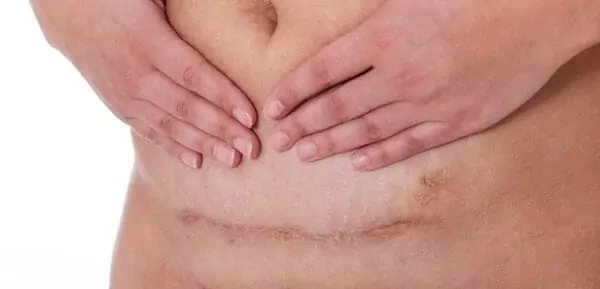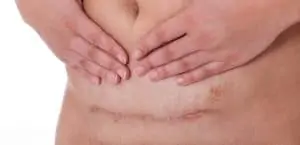Both my c-sections required time for recovery. This is true for any mama that brings a baby into the world this way. But it’s even more true for overweight mamas.
Knowing how to take care of your c-section incision is so important that your doctor or the nurses at the hospital will go over it with you. They’ll likely send you home with a paper or pamphlet too.
The reason? You need that incision to heal properly. That’s something any c-section mama has to do, but for mamas with belly apron, it’s extra important because that extra skin flap can make it harder for your wound to heal.
Why overweight women need to be more mindful of c-section incision care
By and large, we’ve come a long way with c-sections. They’re still major surgery, but they’re so routine that they tend to go smoothly.
Of the complications surrounding them, the wound complications are most abundant in obese women. Roughly 10% of women that are overweight and have a c-section have wound complications, including wound separation and infection.
The reason is that your abdomen is bigger, so the incision is deeper. This can lead to more blood vessels to rupture. Plus, the impact obesity has on immunity and the skin barrier makes you more susceptible to infection.
Larger mamas with c-sections are at greater risk because excessive fluid seeps from the fatty tissue both in and around your incision. It’s colorless and odorless, and mostly harmless. But once it accumulates, it can make for a moist environment, the perfect storm for an infection to brew.
That’s why keeping the c-section wound dry is vital for every mama, but even more so for overweight mamas.
How do I keep my c-section incision dry and clean when I’m overweight?
I have some excellent tips to help you keep your incision site dry even if you’ve got belly overhang in the way. That belly apron can trap moisture, making you more prone to infection.

What can you do? Try these tips!
Use a sanitary napkin
These things are great for soaking up moisture. Put the soft side down on the incision while the sticky adhesive side can be applied to the inside of your underwear.
However, please change the pad often. You don’t want to leave it there soaked, and it can cause more trouble.
Try a towel
A clean, dry hand towel may be another solution to contend with that fold of skin folded over your incision site. This is especially helpful if you sweat frequently or it’s hot outside which will cause you to sweat.
Like the sanitary napkin suggestion, you’ll also want to swap out the towel frequently because a wet towel isn’t going to help you keep the area dry.
Use the cool setting on your hairdryer
This tip will require assistance from your husband or a loved one. You’ll want to hold up your belly overhang and have your partner dry it using the cold setting on your hairdryer.
You might think taping your belly up would be a good idea, but I urge you not to do this. You can cause damage to your skin that will hurt even worse.
Wear the right clothing
Letting the incision site air out helps it heal. Loose gowns for sleeping are good if you can keep the overhang off the incision. A great way to do this is by wearing high-waisted underwear.
Go with cotton or gauze
Chances are, if you’ve got an apron belly, they will help you with some gauze in the hospital. This can keep the area dry and protected from that skin shelf. As they help change your dressing, ask them about it and learn how to do it for yourself so that you can take care of it when you’re home.
Cleaning your c-section incision when overweight
For all c-section mamas, you need to keep your c-section incision clean and dry. Yes, you can shower (unless your doctor tells you otherwise), and it’s best to use warm soapy water. Make sure you rinse it well and then gently pat the dry area.
For gooey or crusty junk on the incision, a cotton swab dipped in a 50/50 mix of hydrogen peroxide and water can help you gently clean the area. Bubbling is normal as it releases oxygen. After that, use a pad or gauze to keep that area dry.
How to know if your c-section incision is infected
If you follow these tips, you’ll be among the 90% of overweight mamas who have had c-sections that have no troubles at all. But what if you get an infection…how will you know?

It should be obvious with the symptoms. Itchiness is normal and common for everyone with a c-section as the scar heals and is not a cause of concern. However, if you keep scratching at it, you may cause an infection, so keep your hands away!
Infected c-section incision signs are swelling or pain, a foul odor or smelly discharge, watery or bloody discharge, redness, scar separation, achiness, chills, or fever.
If you notice any of these things, get medical attention immediately. You should not ignore it, as an abscess can form if you try to go on like nothing is wrong. This can also infect your uterus; a condition called endometritis.
I have more posts about smells and itching on the c-section incision, so be sure to take a look. All in all, you’ll likely know something isn’t right. But the best course of action is prevention.
Now isn’t the time to feel dismal about having belly overhang but instead, it’s the time to take care of that incision. Once you heal and get the all-clear from your doctor for exercise, you can follow my tips for getting rid of that apron belly. For now, keep that infection away by keeping your incision dry and clean!
Leslie Berry lives with her husband and two young daughters in Los Altos, California, where she loves helping other moms get comfortable with motherhood and embracing the insanity with facts peppered with laughs.
She loves eating too much sushi, exercising, and jamming out on her Fender. Read more about Leslie here.







